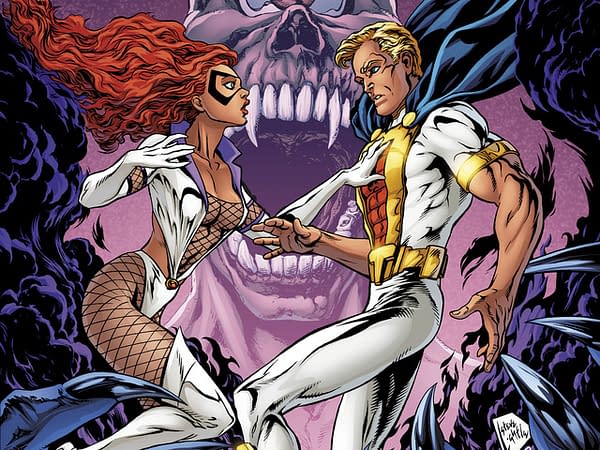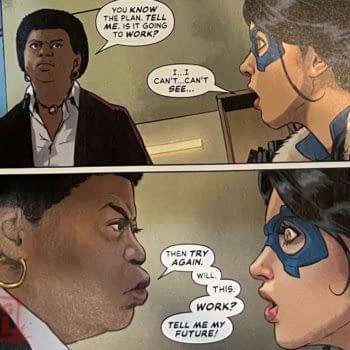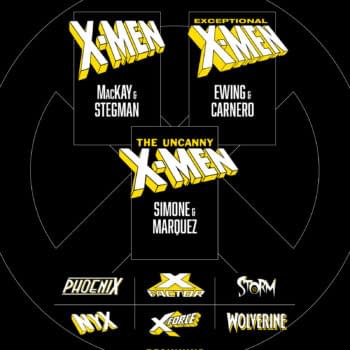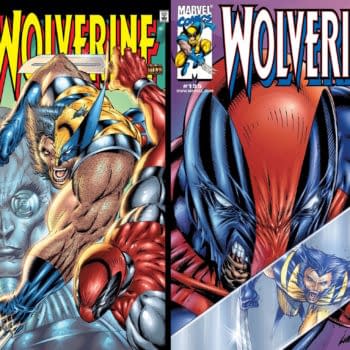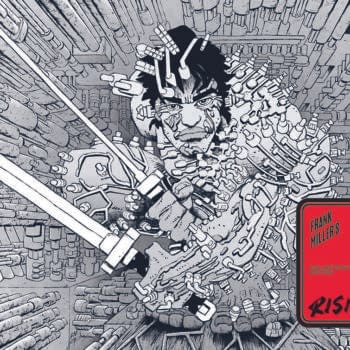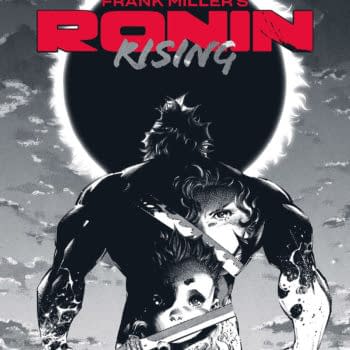Posted in: Comics | Tagged: arcana, cancer, Joe Martino, Red Anvil Comics, Ripperman, Shadowflame, superheroes, The Mighty Titan
The Response To A Superhero With Cancer
Robert J. Sodaaro writes;
"Faster than a speeding bullet! More powerful than a locomotive! Able to leap tall buildings in a single bound!"
These are the words that kicked of the 1941 animated Superman shorts, as s well as that 1952–1958 live-action TV show (that ran in syndication well into the '60s). It was via these words that we came to achieve our understanding of who and what "Superhero" was (a word that had actually been in popular usage since 1917), and rightly so.
This is America, we don't just have heroes — men and women of exceptional abilities — we have individuals and personalities that are larger than life. Folks of myth and legend that loom larger than you and I, people like Paul Bunion, Johnny Appleseed, Davy Crocket, and Daniel Boone. Like the Greek and Roman gods of yore these individuals (both fictional and real) loomed larger than life itself eventually donning masks, capes, and spandex so as to become more than just "heroes" they became "Superheroes" (hence the "Powers and abilities far beyond those of mortal men." part of the quote that followed this article opening line).
Yes, our heroes were nigh immortal. Only, not so much. In 1992, in what became a seminal tipping point in the history of comicbooks, DC comics did the unthinkable. They killed Superman (Superman #75). Yes, the man of steel was beaten to death by the otherworldly doomsday alien, Doomsday. This set off a chain of events that is still being felt today in the comicbook field. Sure, sure, in the '60s Stan Lee and his merry band of writers and artists famously gave their heroes feet of clay, making them more human than super, but to actually kill an iconic character such as Superman, now that was something to write about it, and (as can be expected) nearly every news organization in the world did just that. Superman is dead.
What now?
When a King dies, it is "The King is dead, long live the King!" and a new heir is named immediately. When a President dies in office, the VP is sworn in almost immediately. When a Pope dies, the world stops until a new one is appointed. Yet, what do you do when a hero the magnitude of Superman dies? Well. It became both a media even as well as something of a feeding frenzy as collectors, speculators, and the mildly curious swarmed into comicbook shops to get their hands on those issues and the ones that followed to find out. As it turns out, the entire event was (at best) a great tale that was told and (at worse) a calculated marketing event designed to separate rubes from their money.
Still, it set a tone, and it got other creators to wondering, what would happen if a hero died? For writer/artist Joe Martino (who was diagnosed with Kidney cancer in 2004 and again in '07) he began to think about what would happen if a "traditional" costumed superhero contracted this very human disease and had to (as a "superior" human) deal with this very tragic, and compelling situation? Thus was born The Mighty Titan, a hero with mythical-level, god-like powers who had cancer. According to Martino, Titan is (like Billy Batson/Captain Marvel before him), something of a cross between Superman (the creature of science) and Thor (the creature of mythology and legend) before him; and he has cancer.
Yeah, you read that right; an over-muscled, spandex-clad superhero with powers and abilities far beyond those of mortal men has cancer. What's more, Martino is not shy about telling people that the reason he decided to create a character with such a horrific and debilitating illness is that, he himself is a cancer survivor. "The story essentially takes the experience I personally went through with cancer and wraps it up in a superhero shell," Martino (the father of three), tells us. Needless to say, this isn't Our Cancer Year with tights and capes, it is a superhero tale with a very human element. "I have researched and talked to other cancer survivors," Martino stated, "In order to try and get the feeling of what other people have experienced."
Martino said that it was a very tough decision for him to take some of his own personal experiences and put them down on paper in order to entertain people. Still, he felt that if he did this it would possibly allow readers to have a glimpse into what some cancer patients go through while battling this potentially deadly disease. In spite of the underlying subject matter, Martino is quick to point out that while Titan's story has some very grim aspects to it, it is still a cool, fun superhero book — full of vile villains, giant robots, and some really great mythological creatures.
Needless to say, the concept, subject matter and execution of the book has hit something of a responsive chord in the series readers, allowing Martino to successfully launch not one, but three separate Kickstarter fund drives in order to underwrite the project. The second two of which went fully funded within 30 and 36 hours respectively (the third and current Kickstarter — which had a goal of $2,350 has just topped $5K, and is still going strong with eight days to go). Martino — whose comicbook credits include Shadowflame and Ripperman (both from Arcana) as well as other work as a number of other indie publishers — in 1996 founded his own publishing company JGM Comics in order to publish his own work. On his first Mighty Titan Kickstarter go-round (August, 2012), he successfully raised over $12,000 in 40 days with 378 backers. As simple as this may sound, it wasn't an easy task for Martino. "People seem to think that Kickstarter is a 'set it and forget it' process. It isn't, you need to be pimping it every day 24/7." In fact Martino revealed that his first Kickstarter project was so stressful that actually put him in the hospital.
Never one to shy away from doing what it takes to make his dreams come true, in May of 2013, Martino went back to the well, listing the second issue of The Mighty Titan for funding on Kickstarter. Fortunately, this time around, utilizing what he had learned on his first go-round he managed to once again tap into the zeitgeist of his fan base for its support allowing his second Kickstarter to achieve an amazing response. Within 30 hours the book rocketed to well above the goal amount, allowing Martino to initiate a number of "stretch" goals — that is to say additional rewards for supporters who help him soar to even greater heights as the clock ticked down to the end of the promotion. Those stretch goals included some very cool items for participants of the second issue, and included prints by Jimbo Salgado and Fred Hembeck as well as an additional free comic with a variant cover by Bryan Hitch.
The Mighty Titan is slated to be a five-issue series, with the possibility of a second limited series depending upon the success of this initial run. Still, given the amazing support that he has seen thus far, Martino is fairly confident that we'll be seeing quite a bit more of Titan in the not-too distant future. Now that his third issue is fully funded, Martino is really pushing the envelope with this Kickstarter promotion. With eight days to go (the project concluds on Sunday Nov 17, 2013) Martino is looking to hit $7,000.00, which —if he hits it —states that it will fully fund issue #4 (with a cover by veteran comicbook illustrator Bob McLeod), and if that happens, he will send a copy of #4 to everyone who pledged above $20. (If he hits $9,000.00 everyone with a shippable reward will get a copy of issue # 4 with the McLeod cover).
For fans of Bleeding Cool who read this article and then contribute to the Kickstarter, Martino is adding a new, very special stretch goal. Mention that you read this article on Bleeding Cool and you will receive (in adittion to whatever other goal to which you are entitled) a desktop wallpaper and digital three-pack reward — for this special level contributors will get a Bleeding Cool Titan exclusive wallpaper and the first Three issues of The Mighty Titan in digital form.
__________
Robert J. Sodaro who is something of a Heroist himself, has been reviewing comicbooks for some 30 years. During that time, his reviews and articles have appeared in numerous print publications, as well as on the web


